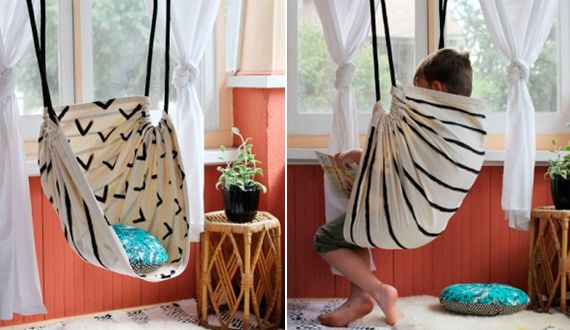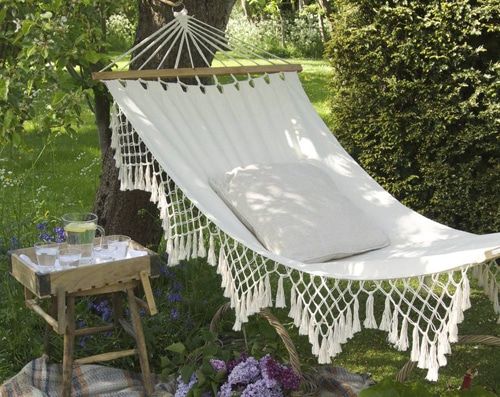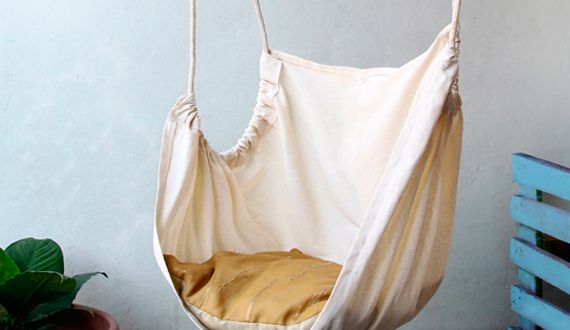DIY hammock swing
 For many people, the dacha is the best place to relax and it is difficult to imagine a country house without a hanging swing chair or hammock. In stores you can purchase these structures in various sizes and any shape. But you can save money and make garden furniture yourself.
For many people, the dacha is the best place to relax and it is difficult to imagine a country house without a hanging swing chair or hammock. In stores you can purchase these structures in various sizes and any shape. But you can save money and make garden furniture yourself.
The content of the article
How to make a hammock swing with your own hands
There are several types of hammock chairs:
- With a soft frame (like a hammock). The main difference is the size: this hanging chair is smaller in size, unlike a hammock, and therefore takes up little usable space.
- With a rigid plastic frame or rattan structure. This swing is covered with thick fabric.
- "A drop". In appearance, this structure resembles a small house; it is often equipped with doors.
- Cocoon swing. A special feature of the modification is that the space inside the hammock is 80% closed. This effect can be achieved through wicker walls - macrame.

What will it take?
Making a hanging hammock chair is very simple. First you need to prepare the tools and materials that are required for the work:
- scissors;
- gloves;
- durable fabric;
- roulette;
- braid;
- frame base - hoops made of wood, metal, plastic or acrylic;
- accessories (buckles and ring) for installing a hammock;
- interlining;
- foam;
- polyamide threads;
- slings.

How to choose the right material
For the base, you can use various materials, including natural and synthetic. But not every one is suitable in every specific case, so you need to know all the advantages and disadvantages of each material. The most popular are the following:
- Cotton is the most common material. It is light, durable, pleasant to the touch, breathable and washable. But in terms of service life, cotton is not a durable material, so after a few years it requires replacement;
- The mesh is evenly woven strands, which are secured on the sides with wooden beams with holders. Usually the material for production is twine with a thickness of at least 5 mm. The mesh has a long service life and is easy to maintain. But there are also disadvantages - it often rubs the skin, so you can only stay on it for a long time with an additional layer of soft material;
- Burlap is a material made from yarn. As a rule, it is made from fibers of jute, hemp, and kenaf. The material is characterized by good strength, ability to “breathe” and low cost. But lying on burlap without a bedding is uncomfortable, since it is quite prickly to the touch;
- Silk is an ideal material that has the required strength, vapor permeability and wear resistance. Silk is washable and dries quickly. There is only one drawback - high cost;
- Tarpaulin is a thick, waterproof synthetic or natural material. It is based on hemp, flax or sesame fiber, which is treated with various impregnations. Tarpaulin is wear-resistant and fireproof, but is quite heavy and has poor vapor permeability;
- Polyester is a universal material that is durable, but at the same time quite lightweight. Therefore, synthetic fabric is very popular among tourists, for whom any extra few kilograms in a backpack is a problem. But polyester is not fire resistant, so any spark can make a hole in the base. In addition, the material does not “breathe”, which creates significant discomfort.

Ways to secure the structure
Most people do not classify swing hammocks as a specific group of country furniture, since they can be made in any form. But still they belong to a separate class. As a rule, these swings are made in a classic shape or in the form of a chair.
Attention! A characteristic feature of this type of furniture are 2 support points located at a certain distance, this creates the principle of pendulum operation.
Swing chairs can be of two types:
- Mobile - the product is attached to a rod, which serves as a stand. This solution allows the structure to be moved throughout the entire territory and removed into the house in winter.
- Stationary - the hammock is attached to a fixed support (beam, tree).

Hammock swing yourself: step-by-step instructions
Assembly and installation of a simple swing hammock occurs in several stages:
- Cut the fabric to the required dimensions and make a frame for it. To do this, you need to sew a rope along the long edges and bring its ends parallel. That is, the product will have 4 pieces of rope, which must subsequently be used for fastening.
- Drill several holes in the beams along the entire length in increments of 7-12 cm.
- Pull the cord through the holes, then secure them with knots.
- Cut strips of rope measuring 50 centimeters according to the number of holes on the beams.
- Fix the strips of rope with one end to the beam and the other to the steel ring.
- Tightly wrap the remaining rope around the supports and make loops along the edges; they will be needed to secure the structure.
- Secure the rings and loops with a carabiner on both sides. The swing-hammock is ready.

A wicker or fabric swing hammock is an excellent option that can replace bulky and rather expensive garden furniture, and due to its mobility, this structure can be installed anywhere in the garden.





